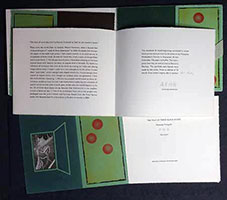 The Tale of Three Black Boxes By Shinsuke Minegishi Vancouver, British Columbia: Heavenly Monkey, 2006. Edition of 25. 8.5 x 7". Text set in 12-point Gill Sans. Printed on the Heavenly Monkey handpress. Engravings printed by the artist on gampi from the studio of Shiho Nao in Japan, and then archivally mounted on the Arches text sheets. Sheets sewn in a single signature, and put into a black wrap with the image of three boxes embossed on the front cover, and debossed on the rear. In black slip case with paper titles on spine. Signed and numbered by the artist. Heavenly Monkey: "This project is Minegishi's most personal book work to date, merging and juxtaposing his interests in fine art printmaking and hand-crafted books. It is also his most ambitious publishing project to date, hence the small edition of just 25 sets, with five reserved for distribution exclusively in Japan. The book and portfolio (both measuring 8.5 x 7 inches) in each set feature descriptive colophons, numbered and signed by Minegishi (English in the book, Japanese in the portfolio). The core of the project consists of six wood engravings (each about 3 inches square) that tell a sequential narrative about the adventures of a family of three black boxes. This story is told, with spare text, in a single signature book. "A companion case holds a suite of six prints that delve more deeply into the specific imagery of each engraving. The multi-layer prints are color woodcuts that incorporate an engraving, through windows and openings cut into the printed sheet. The textures and colors created with the woodcuts are achieved through multiple inkings and overprinting. The six prints — along with a title sheet, brief commentary by the artist, and colophon — are held loose in a black portfolio case. This & the set's matching slipcase are made by the artist." Shinsuke Minegishi, introduction: "I am interested in exploring the existence of parallel worlds in some other time & space. In this case, the world happens to be the life of three black boxes (three, because that traditionally is the smallest number a family can be)." Text: "Three black boxes lived in a city where all the other boxes looked the same."
|